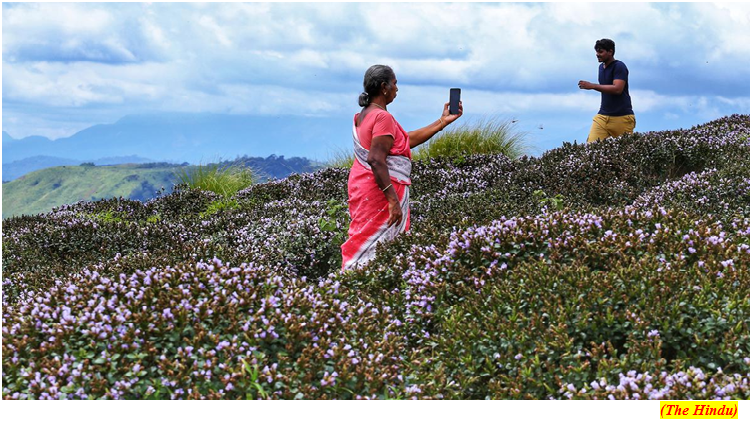Scientists find underground areas on Mars that could be more habitable than surface (GS Paper 3, Science and Tech)

Why in news?
- The Curiosity rover, operating on the surface of the Gale crater on Mars, has made a revealing discovery.
Details:
- Scientists have found that the fracture halos under the surface contain water-rich opal, potentially serving as an important resource for human exploration.
- Analysis of data by neutron spectrometer Dynamic Albedo of Neutrons, or DAN revealed that the vast subsurface fracture networks would have provided water-rich and radiation-shielded conditions. These could be potentially more habitable than those on the surface.
Fracture halos:
- The fracture halos are light-toned opaline silica features found throughout rocks and are made from the exposed roots of a vast fluid event in recent Martian geologic history.
- Researchers looked at the old images captured by the Curiosity rover and found a huge expanse of fracture halos extending far into the distance.
- They found that these halos not only looked like halos found much later in the mission, in completely different rock units but were similar in their composition: a whole lot of silica and water.
Formation:
- The discovery of opal is noteworthy as it can form in scenarios where silica is in solution with water, a similar process to dissolving sugar or salt in water. If there is too much salt, or conditions change, it begins to settle at the bottom.
- Water-rich environments in the subsurface of Mars could have provided a safe haven from the harsh conditions on Mars' surface, which is rather inhospitable compared to Earth.
Gale Crater:
- The Gale Crater on Mars is known for cold and harsh temperatures that go down to -70 degrees Celsius.
- Given the widespread fracture networks discovered in Gale Crater, it's reasonable to expect that these potentially habitable subsurface conditions extended to many other regions of Gale Crater as well, and perhaps in other regions of Mars.
- These environments would have formed long after the ancient lakes in Gale Crater dried up.
80% shortfall of specialist doctors in CHCs Health Ministry report
(GS Paper 2, Health)
Why in news?
- Recently, the Rural Health Statistics report was published by Ministry of Health and Family Welfare.

Vacancy in CHCs:
- India is reeling under an acute shortage of specialist doctors, with a shortfall of nearly 80% of the required specialists at Community Health Centres (CHCs).
- CHCs are 30-bed block-level health facilities which are ideally supposed to provide basic care related to surgery, gynaecology, paediatrics and general medicine.
Key Highlights:
- There is a shortfall of specialist doctors, including surgeons (83.2%), obstetricians and gynaecologists (74.2%), physicians (79.1%) and paediatricians (81.6%).
- There are 6,064 CHCs across India and the Health Ministry has been unsuccessful in meeting the requirement for specialist doctors in most of these centres.
- This is despite the fact that, in 2005, the number of specialist doctors in CHCs was 3,550, which has seen a 25% increase to 4,485 in 2022. However, with the number of CHCs growing, the requirement for specialist doctors required to make the centres functional has also increased.
- Requirements of specialist doctors in CHCs has increased by 63.8%, whereas there is only an increase of 26.3% in the actual number of in-position specialists.
- Apart from specialist doctors, there is also a shortage of female health workers and auxiliary nursing midwives, with upto 14.4% of these posts lying vacant in primary health centres and sub-centres.
Recommendations:
- The funds should be provided for outsourcing and providing support services according to the need of each centre.
- It recommends that nursing orderlies be trained in the assistive procedures required for surgery.
Centre puts Neelakurinji on the list of protected plants
(GS Paper 3, Environment)
Why in news?
- The Ministry of Environment, Forest and Climate Change (MoEF) has listed Neelakurinji (Strobilanthes kunthiana) under Schedule III of the Wildlife (Protection) Act, 1972 including it on the list of protected plants.

Key Highlights:
- Those who uproot or destroy the plant will invite a fine of ₹25,000 and three years imprisonment.
- The cultivation of Neelakurinji and its possession is not allowed.
- Neelakurinji was included when the Centre expanded the earlier protected list of six plant species to 19.
- As per the new order, the department will take action against those who uproot or destroy Neelakurinji in forest areas, protected areas, and national parks. The department will strictly implement the government order.
Habitat:
- The plant was endemic to a small stretch in the Western Ghats from the Mangaladevi hills to the Nilgiris hills.
- In the Western Ghats region, nearly 70 varieties of Neelakurinji plants have been identified.
- The most popular Neelakurinji is Strobilanthes kunthiana that blooms once in 12 years. However, some other rare varieties of Neelakurnji are also found in the Western Ghats region.
Recent bloom:
- The most recent blooming of Neelakurinji was over a vast area on the Kallippara hills at Santhanpara in Idukki. An expert team had identified six varieties of the plant across the mountains.
- The Eravikulam National Park, near Munnar, is known for widespread blooming of the kurinji, with the next flowering season expected in 2030.




